Cooch Behar Jewelry
Written by : Amita Roy
Dated: December 26,2017
Share
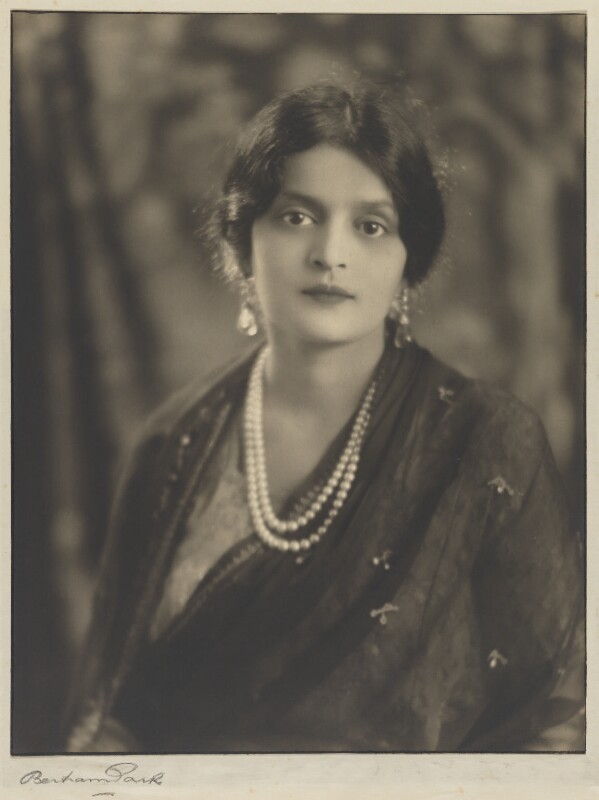
Maharani of Cooch Behar , Indira Raje, 1919. National Portrait Gallery
Imagine you are a Princess whose movements and interactions are absolutely restricted by royal protocols and traditions and suddenly you happen to be the first one who is exposed to a beautiful luxurious world outside your demarcations. You become an Alice in Wonderland. Your experiences influence your style. Royalty itself is such a wonderland where precious jewelry is one of its main fruits. Each piece of a royal jewelry has a soul which speaks its own story in its own distinct style.
Such a royal family was the erstwhile state of Cooch Behar which was a 13 gun salute erstwhile princely state, ruled by Koch dynasty, tucked away in the foothills of the majestic Eastern Himalayas in north Bengal. Though it was very small in area compared to the other biggies of its time like Hyderabad , Jaipur, Mysore or Kashmir but as they say, size doesn’t matters. But being a smaller state, it did packed a punch.
Cooch Behar was the first princely state where British did an experiment of sending the minor ruler to England for higher education under the guardianship of an English Colonel. It was the British administration who fixed the wedding of the Maharaja with a Bengali girl from another faith, Brahmo religion in 1877. This girl was none other than Brahmo leader Kesava Chandra Sen’s elder daughter Suniti Devi. Suniti Devi had a liberal upbringing with a modern English education. Though this happened to be the first interfaith royal marriage but it had its own share of controversies. She had class and poise and a famous fashionista among Indian royals of her time. Besides she had a great collection of jewelry which she commissioned and created through Indian and European jewelers. Suniti Devi was also the first Indian Maharani who crossed the ‘Black Seas’ or Kala Paani to attend Queen Victoria’s Jubilee in 1887. She was accompanied by her husband and three little children.
In her memoirs named "The Autobiography of An Indian Princess" , a first of its kind autobiography written by a Maharani, she gives vivid description of the jewelry she observes in India and England. She also gives the subtle difference of style and wearing of jewelry in both the cultures. She observes that minimalistic is the style in England whereas in India maximum display of gold is a sign of prosperity. She weaves jewelry as a part of religious customs and traditions like gifts of jewels to a bride which she received as a daughter and also showered it on her elder daughter Sukriti during her wedding in 1899. She valued her diamond and turquoise wedding ring given by the Maharaja as her most precious possession. When she arrived for the Jubilee functions in England for the first time, she was introduced to many European royalties and aristocracies who were in their national costumes with splendid matching jewels. Suniti Devi presented on behalf of Maharaja of Cooch Behar a diamond pendant with an uncut ruby in the middle to the Queen as a personal gift. Later, Queen honored her with the Crown of India medal.
Similar accounts of the fabulous jewelry collection of Cooch Behar royal cache can also be had from the accounts of the then British officers, various national and international newspaper archives. Cooch Behar had the finest pearl collection in the world. Suniti Devi owned a diamond encrusted tiara that she wore during the coronation of King Edward VII in 1902. Her collection also included diamond and pearl encrusted bangles, heavy necklaces with Indo European motifs. There is a story that she owned a necklace made of pearl and turquoise but she faced bad fortune due to it. She was robbed of precious jewelry and her husband faced loss in the races. One pandit advised her to change the ownership of the necklace and make a sea voyage. Later her daughter Princess Pretiva owned it.
But it was Suniti Devi’s daughter in law , the Baroda princess and later Maharani of Cooch Behar Indiraraje whose legendary charisma brought the zenith of the lifestyle of the royal family. The stunning daughter of Maharaja of Baroda Shrimant Sayajirao Gaekwar went on to become the legendary socialite and a globe trotter, she was the first Indian Maharani who in a true sense can be called Diva. The moderately liberal atmosphere of the Baroda royal family framed the broadminded Indira whose love story followed by subsequent marriage was a sensation in the contemporary Indian princely society. . The most stylist Maharani of her time, an Europhile, a very warm hostess she exuded class and was renowned for her immensely spectacular collection of jewelry a part of which she inherited and a part she commissioned to Cartier, Chaumet, Van Cleef & Arpels, Boucheron, Ostertag. But prior to that, she became a sensation for the global press in the 1910’s due to her breaking up of engagement with Maharaja of Gwalior, Madhorao Scindia to marry the love of her life the later Maharaja of Cooch Behar, Jeetendra Narayan who is also 2nd son of Sunity Devi in England in 1913.
Indira Raje was welcomed into the royal family after the famous marriage in 1913 at London with lots of jewelry. The then Maharaja gave her pearl and diamond tiara with diamond Indira brooch. Her mother – in – law gave her diamond and platinum bag, pearl and cabochon emerald necklace with pearl gypsy earrings. Her husband gave her pearl and diamond negligee , diamond and emerald crest brooch ruby and diamond watch pendant with pearl and gold chain. Later she owned many famous pieces like ropes of pearls and emeralds, emerald neck piece worth Sterling Pound 800,000 which she wore during Jubilee Day in London in 1935. She also commissioned more than 100 pair of shoes to Salvatore Ferragamo out of which a pair was made on green velvet encrusted with pearls and another pair was made of black velvet set with diamonds.
Indiraraje’s flamboyance was evident from the fact that being an avid gambler in Paris, she always a carried a small live tortoise as a talisman whose back was encrusted with diamonds, rubies and emeralds. Though she was widowed at the age of 30, she made the negative white symbol of widowhood into an eternal style statement. As she was limited to wearing certain colors, she combined those light colors with the fabric known as French Chiffon paired with pearl jewelry a rage that is still in vogue amongst royalty even today.
The men in the Cooch Behar royal family also had a fine taste for jewelry. They used to wear diamond sarpech, diamond and gold necklace , pearl necklace even with clothing emblazoned with pearls of flowery pattern simulating branches of grapes.
Post 1947, if any of the Indian royalty wanted to travel abroad, they needed to take the permission of the Indian Government that they are taking along with them precious jewelry with their checked and declared value. We come across such instances when Maharani of Cooch Behar, Indira Raje requested Mr C. S. Venkatachar, the then Secretary to Ministry of States, Govt. of India for permission to take along with her jewelry worth Rs. 1.5 lakhs to Europe which she promised to bring back on her return with her.
After the death of Indira Raje and her son Jagaddipendra Narayan, the last Maharaja of Cooch Behar squandered the magnificent collection. He sold it off along with wife of Jagaddipendra Narayan, Maharani Gina Egan.

Colonel H.H. Maharaja Shri Sir Nripendra Narayan Bhup Bahadur, Maharaja of Cooch Behar, GCIE
Date: 6 January 1899.
Occasion: Visit to England after NW Frontier Campaign. Location: Lafayette studio, 179 New Bond Street, London.
Dismounted review order uniform of a British officer of 6th (Prince of Wales's) Bengal Cavalry. Dark blue with scarlet collar and cuffs, all with gold lace and braid. Pouch belt, 2½" wide, laced in gold. Front of tunic adorned with five rows of round-backed gold cord. Sleeves carry the Bengal Knot. Aiguillette on right shoulder.
Copyright – Victoria & Albert Museum, London, UK
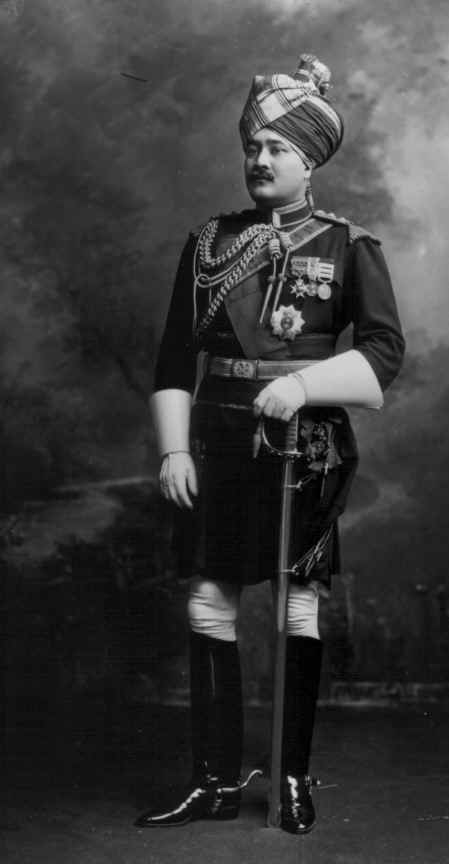
Colonel H.H. Maharaja Shri Sir Nripendra Narayan Bhup Bahadur, Maharaja of Cooch Behar, GCIE
Date: 11 August 1902
Occasion: Visit to England as A.D.C. to King Edward VII at the Coronation of 1902.
Location: Lafayette studio, 179 New Bond Street, London.
Costume: Review order uniform of the 6th (Prince of Wales's) Bengal Cavalry. Officer's Kurta of 1897 period (with pockets), scarlet facings and lace gold. Blue turban, with blue, white and gold stripes, the kulla red and gold. Scarlet cummerbund with gold. Belt buckle with VR monogram.
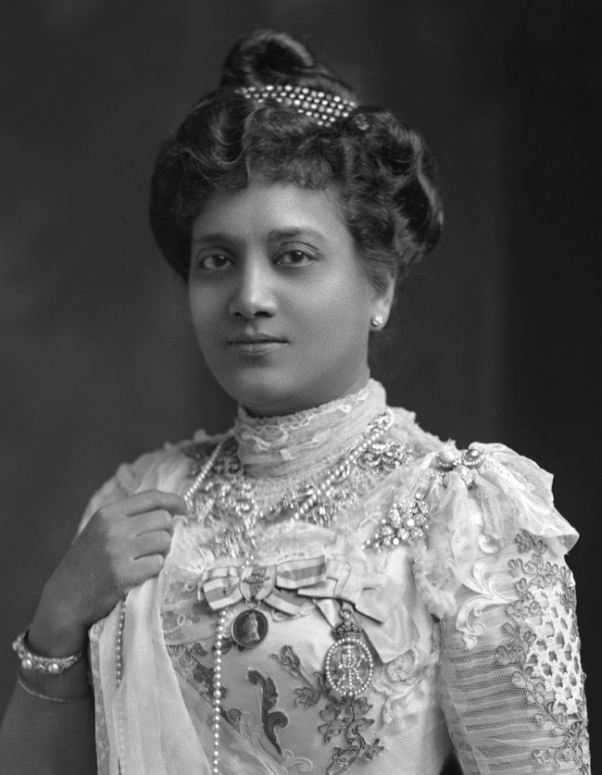
Maharani of Cooch Behar Sunity Devi (1864-1932)
Date: 9 November 1900.
Location: The Lafayette Studio, 179, New Bond Street, London.
Costume: The Maharani's dress is made of silk with appliqué decoration, and a filmy muslin wrap draped over the top, perhaps recalling the Indian dupatta or orhni draped over the head and shoulders.
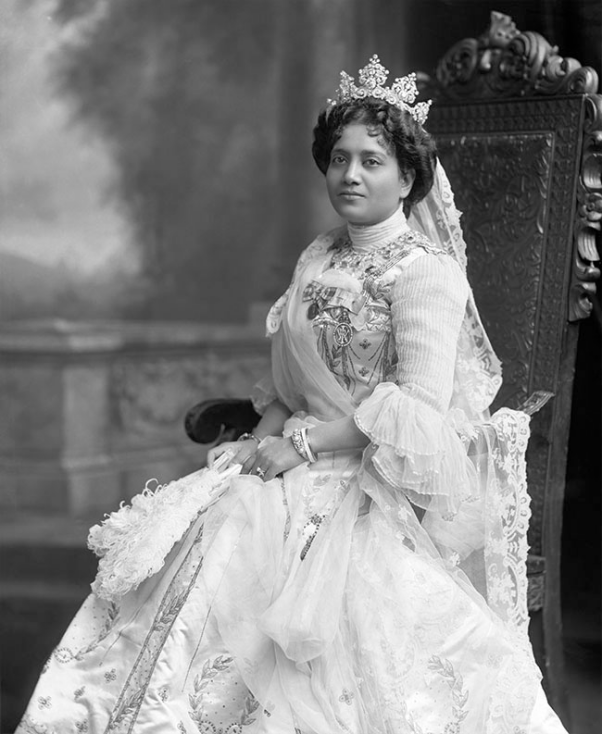
Maharani of Cooch Behar, Sunity Devi C.I.
Date: 9 August 1902.
Occasion: The Coronation of King Edward VII, 9 August 1902.
Location: The Lafayette Studio, 179, New Bond Street, London, W.
Descr: TQL seated.
Costume: Gown of white satin with 'Empire' wreath design embroidered in gold - worn at the Coronation ceremony.
Costume Supplier: Made by 'a French milliner'.
Orders, Decorations & Medals: Badge of the Imperial Order of the Crown of India, [C.I. cr. 18 March 1887]; Queen Victoria Jubilee Medal 1887, with 1897 bar.

Maharani of Cooch Behar Sunity Devi CI (1864-1932)
Date: 31 August 1910
Occasion: Visit to England occasioned by the health of the Maharaja.
Location: The Lafayette Studio, 179, New Bond Street, London.
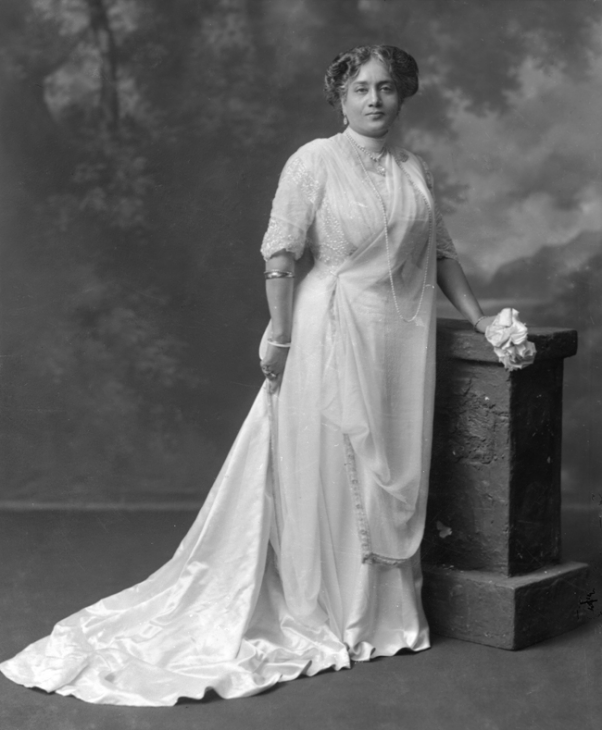
Maharani of Cooch Behar Sunity Devi CI (1864-1932)
Date: 31 August 1910.
Occasion: Visit to England occasioned by the health of the Maharaja.
Location: The Lafayette Studio, 179, New Bond Street, London.
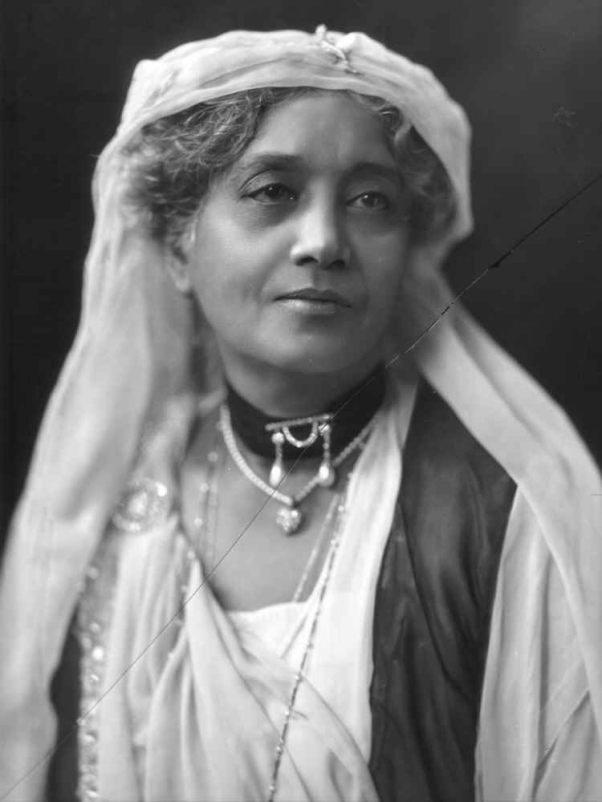
Maharani of Cooch Behar Sunity Devi (1864-1932)
Date: 1 February 1921.
Occasion: Visit to England (possibly in connection with the publication of her autobiography).
Location: The Lafayette Studio, 179, New Bond Street, London.
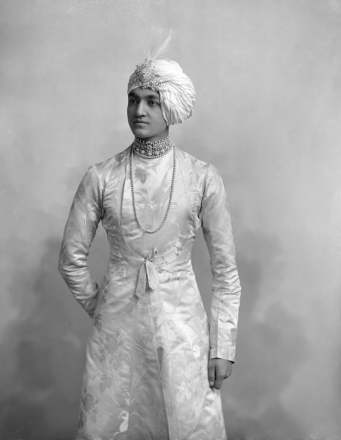
H.H. Maharaja Shri Raj Rajeshwar Narayan Bhup Bahadur, Maharaja of Cooch-Behar (1882-1913)
Date: 23 October 1902.
Occasion: -
Location: The Lafayette studio, 179 New Bond Street, London.
Costume: " The prince wears an angarkha (robe with circular front opening) made of European silk, probably in pale blue. His magnificence turban jewel sprouts an egret feather."
Jewellery: Cooch Behar Diamond sarpech, diamond and gold necklace
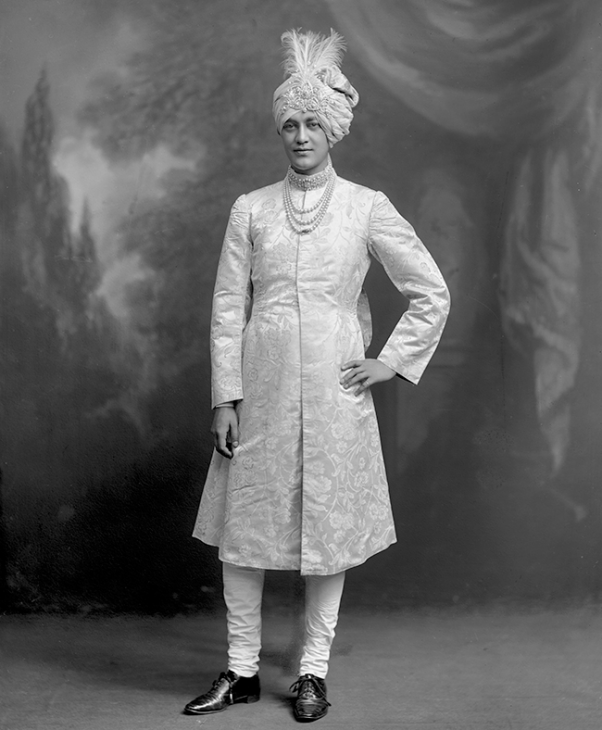
H.H. Maharaja Shri Sir Jitendra Narayan Bhup Bahadur, Maharaja of Cooch-Behar (1886-1922)
Date: 26 September 1913.
Occasion: -
Location: The Lafayette Studio, 179 New Bond Street, London.
Jewellery: Diamond sarpech, diamond and gold necklace [worn by his brother in 1902 image], three row pearl necklace
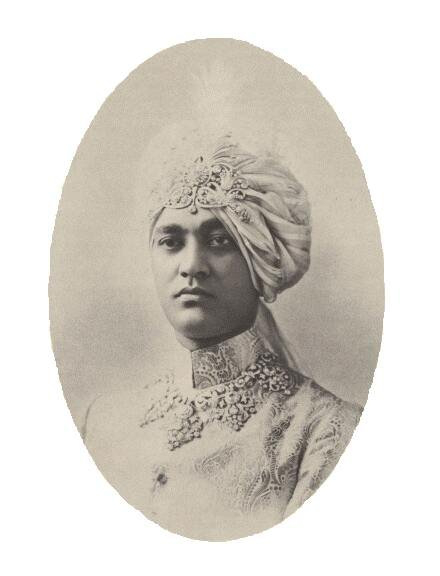
Maharaja of Cooch Behar Jeetendra Narayan. Close up in jewels.
All the above photos © Victoria and Albert Museum , Lafayette Studio Collection, London, UK
Following are the photos of Maharani of Cooch Behar Indira Raje (1892-1968) who was former Princess of Baroda. The following photos are courtesy Mr Jones, owner of Victor Bros Auction House, Kolkata.

In her trademark Chiffon and Pearls. 1936.

Side view of Maharani Indira Raje, 1928
The following photo is courtesy – National Library of Australia, 1936. A proof of her being an international socialite.

Bibliography –
- Sunity Devi, Maharani of Cooch Behar, The Autobiography of an Indian Princess, John Murray, London, 1921.
- Gayatri Devi, Santha Rama Rao, A Princess Remembers – The Memoirs of Maharani of Jaipur, Rupa Publications, New Delhi, 1996.
- Ministry of States File, National Archives of India, Delhi
- National Library of Australia
Co -authored by Amita Roy, this is an excerpt from the coffee table book named 'Treasure Trove' published by Gem and Jewellery Promotion Council of India and Art of Jewellery published on 28.7.2017 in Mumbai.
